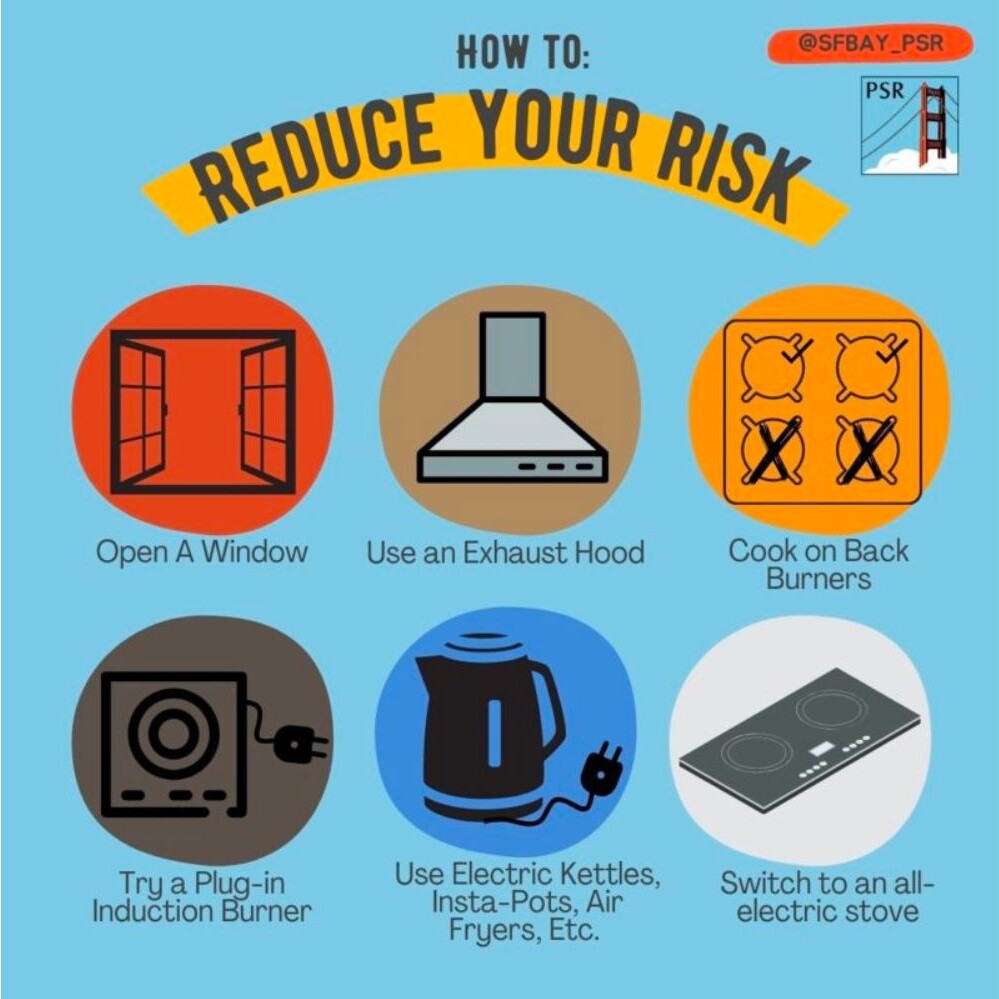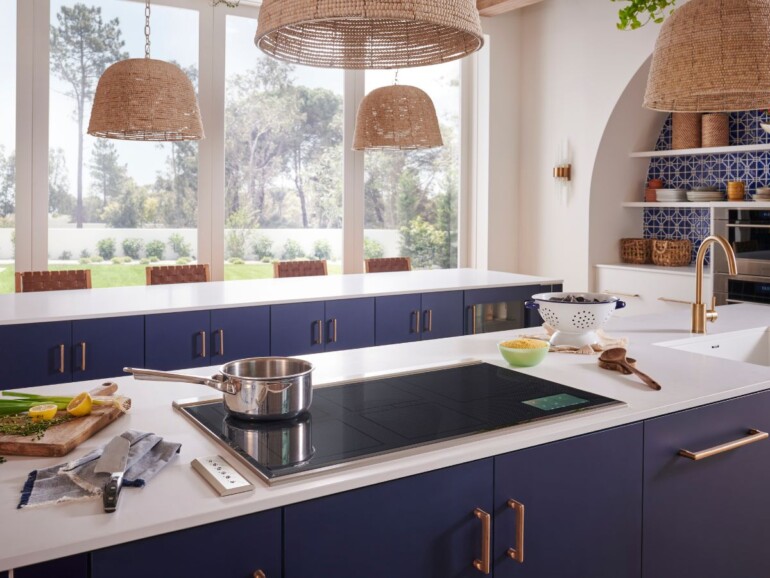If you’re committed to healthy cooking, then it’s time to ditch that gas-powered stovetop. A recent study, conducted in 159 homes across California (including some served by PG&E) discovered that gas appliances leak gas even when turned off, and that the leaked natural gas contains hazardous air pollutants, including benzene — a cancer-causing chemical with no “safe” limit of exposure — as well as unhealthy levels of nitrogen dioxide, carbon monoxide, and formaldehyde.
The discovery of benzene in the samples was particularly alarming to researchers because benzene causes human cells to malfunction, with symptoms including tremors, irregular heartbeat, headaches, confusion, dizziness, and even death. Even if benzene levels are low, the CDC warns that the toxic chemical can accumulate in the body over a lifetime, leading to impacts including cancer, anemia, excessive bleeding, irregular menstrual periods, and a weakened immune system.
For years experts have been proving that cooktops, ranges, water heaters, furnaces, and other appliances powered by natural gas increase rates of asthma, respiratory illness, and cardiovascular disease in household members. This study adds the possibility that natural gas appliances might increase cancer rates, too, adding another reason to get rid of gas appliances.
Matt Willis of the Department of Public Health, Marin, explains that the County realized years ago the dangers of natural gas inside homes. “The emissions from these appliances can cause respiratory problems for vulnerable people and increase risk of childhood asthma,” he says. “In some cases, indoor air quality with natural gas use at home is similar to what you’d see with secondhand smoke.”

While all gas appliances — typically stovetops and ranges, water heaters, and furnaces — emit hazardous gases, gas stovetops and ranges are more closely associated with health impacts because they’re in the household living space. Those most affected are likely to be cooks — because they’re near the stoves — and children because their age and size make them more vulnerable to pollutants. While all household members are at risk for elevated levels of asthma, respiratory diseases, and cardiovascular disease, children living in a home with a gas stove have a 42% increased risk of having asthma symptoms.
In addition to immediate and on-the-spot health hazards, gas appliances also contribute to a longer-term and global health hazard: the climate crisis. According to the Marin Climate and Energy Partnership (MCEP) one-third of countywide greenhouse gas emissions in 2020 came from the gas and electricity we use to power our commercial and residential buildings. Because MCE provides us with clean electricity from renewable resources, almost all of those emissions — more than 80% — came from natural gas. California will ban the sale of new gas furnaces and water heaters beginning in 2030, and in the US as a whole, climate concerns have already inspired approximately 80 local governments — including several Marin cities — to pass or consider ordinances to reduce use of natural gas appliances.
Coincidentally, the news about benzene levels in gas broke the same week that Marin County passed an ordinance of its own that aims to speed the phase-out of gas appliances for climate reasons.
“Climate issues are not theoretical concerns,” says Willis. “In Marin this September we saw record high temperatures, and a clear spike in heat-related emergency department visits and hospitalizations. Heat and wildfire smoke events hit the entire population at once, which stresses our bodies and our healthcare system. We need to make the connections. When we think of the climate crisis only as a planet health issue played out over decades, we lose sight of the fact that it’s impacting human health right here and right now.”
As part of its climate action commitments, Marin County offers rebates through Electrify Marin to residents who want to replace appliances that run on natural gas with high-efficiency electric equivalents: induction ranges or stovetops and heat-pump water heaters or furnaces. This means that, unlike many Bay Area residents, Marin residents can “double-dip” on electrification rebates by applying both to the County-run Electrify Marin program and the Bay Area Regional Energy Network (BayREN) program. Propane users can apply for rebates, too, but only through Electrify Marin.
Currently a Marin household looking to replace a gas-powered range with an all-electric induction range can apply for $750 from BayREN and $500 from Electrify Marin, for a total of $1,250, which is just a few hundred dollars less than the cost of a highly rated 30” slide-in induction range. These rebates are not income-dependent, but low-income households can apply for larger rebates.
While the rebates won’t make the transition completely free of charge — the homeowner will likely need to do some electrical work to accommodate the new stovetop or range — they make it more affordable to eliminate hazardous emissions from your kitchen. At the end of the day, you’ll have a cooktop that performs better than any you’ve ever had before, and the peace of mind of knowing that you’ve just reduced the odds of someone in your household developing asthma, respiratory illness, cardiovascular disease, or maybe even cancer.
It’s hard to put a price on that.
While you’re waiting to make the switch, here are some tips for reducing the health risk of having a gas-powered cooktop.

What’s the difference between electric and induction stovetops?
Technical
Both electric (resistance) and induction stovetops are powered by electricity instead of gas, making them a good choice for cooking. Electric stovetops work through resistance: an electrical current flows through a metal coil underneath the glass or ceramic surface and the coil becomes hot and starts glowing due to the electrical resistance. It will transfer its heat through the glass using infrared energy.
Induction cooktops generate energy from an electromagnetic field below the glass cooktop surface, which then transfers current directly to magnetic cookware, causing it to heat up. Since the cooktop itself doesn’t heat directly, it will only be about as warm as a kitchen counter after you’ve put a hot pot on it.
Practical
According to Consumer Reports, induction cooktops and ranges generally outperform every other kind of range. They heat water about twice as fast and can hold a low simmer perfectly. Some key differences with induction:
Cookware: Induction cooktops will only work with magnetic cookware. Cast iron works, as does steel, but aluminum pans won’t. Test with a magnet.
Energy efficiency: Induction cooktops won’t heat up your kitchen on a hot day, and they are 5 – 10% more efficient than electrical, saving both money and time.
Safety: Heating stops as soon as you remove the pan or turn off the stovetop, and the surface doesn’t heat up enough to cause harm.
Performance: More precise and even cooking reduces hot spots and scorching.
Outside the kitchen: replacing gas water heaters and furnaces
Most Marin homes use gas to power water heaters and furnaces, but heat pump technology offers a clean and cost-effective alternative. This technology operates like a fridge in reverse, using electricity to move refrigerant, which picks up heat from one place and releases it in another. Because heat pumps move heat rather than create it, they are highly efficient: while a gas furnace can only reach around 95 percent efficiency, a heat pump can reach 300 or 400 percent efficiency, making around 3 to 4 times as much energy as it consumes.
Water heating makes up 20% of a typical energy bill and space heating is a close second. If you switch to heat pump technology to heat water, your living space, or both, you’ll probably save hundreds of dollars on energy bills each year. Federal income tax credits for heat pump appliances are also available, ask a tax advisor whether you are eligible to claim them.
IRA Rebates and Tax Credits
New federal income tax credits are available through 2032 providing up to $3,200 annually to lower the cost of energy efficient home upgrades by up to 30 percent. Improvements such as installing heat pumps, heat pump water heaters, insulation, doors and windows, as well as electrical panel upgrades, home energy audits and more, are covered by the tax credits and can help families save money on their monthly energy bills for years to come. – EnergyStar.gov
Where do I start?
To transition from a gas cooktop or range to an electric one:
- Measure your current space and begin comparing induction models using Consumer Reports and customer reviews on the websites of many of the “big box” stores such as Home Depot and Best Buy.
- Once you’ve selected your appliance, reach out to an electrician who can investigate your current electrical supply to the area and give you a price for preparing it for your new appliance and capping your gas supply.
- Advertise your old range on Craigslist if you’d like. Someone might want to buy it, which will help offset your costs. You can arrange for the buyer to see it before you disconnect it.
- Schedule the new stove or cooktop to be delivered a few days in advance of this work, so that technicians can pull out the old range, put in the new wiring, cap the gas, and slide in the new range.
- Fill a pan with water and watch in amazement at how quickly it boils! Almost any pan that is magnetic will work on your induction cooktop — even if you previously used that pan on your gas stove. If a pan is warped on the bottom, you can use a rubber mallet to whack it flat so it works on the induction surface.
To transition from a gas water heater to an HPWH:
On average, gas water heaters last just 8-12 years — and they can fail without warning. When yours fails, you will need to replace it quickly — but it could take several weeks to get your electrical system ready for an HPWH.
If your gas water heater is near the end of its life, pre-empt a messy failure and reach out to a contractor who specializes in those appliances to replace it with an HPWH. Alternatively, contact Marin-based ReadySetReplace.com and ask them to help manage your transition. They will arrange for a free evaluation of your system and can either replace it right away or get your wiring set up for a swift replacement when you’re ready—whether that’s when your current heater fails, when your budget allows, or when rebates and incentives are available.
To swap out a gas furnace for a heat pump HVAC:
Reach out to a contractor who specializes in heat pump technologies. Putting in a ductless (mini-split) unit is relatively easy but if you’re looking at installing central HVAC unit, you’ll need a professional.

Anne-Christine Strugnell is a Marin County-based writer whose work has appeared in MORE Magazine, Self, the Christian Science Monitor and the Cup of Comfort series. In 2019, awareness of the climate crisis drove her to focus on climate awareness work with Resilient Neighborhoods, Environmental Forum of Marin and the Climate Reality Project.


